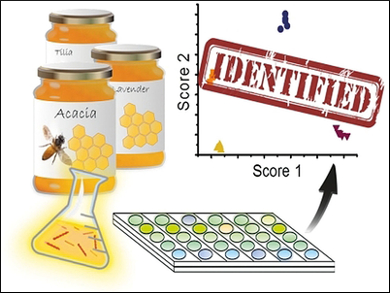The discrimination, control, and identification of complex analytes (beverages, foodstuffs, prescription drugs, etc.) are important for economic and health-related reasons. Because one cannot construct specific sensors for analytes such as honeys, wines, or whiskeys, alternative methods (such as hypothesis-free sensor arrays) are useful for such applications. When using nonspecific optical sensors, the formation of specific intensity patterns of fluorescence is observed, which allows the “fingerprinting” of complex analytes.
Uwe H. F. Bunz and colleagues, University of Heidelberg, Germany, have developed a cross-reactive sensor array by combining a two-component probe system, based upon three viologen-substituted boronic acids (BV) and an anionic charged poly(aryleneethynylene) (PAE), with additional simple PAEs.
The combined system can differentiate 27 different honeys in aqueous solution. The fluorescence turn-on array (BV+PAE) detects saccharide compositions. The PAEs experience fluorescence quenching and can discriminate trace colored components in the honeys. The developed array can also discriminate between glucose-fructose syrup and cheap sugar beet syrups from honeys. Even small amounts of added molasses could be detected.
- An Optical Sensor Array Discriminates Syrups and Honeys,
N. Maximilian Bojanowski, Felix Hainer, Markus Bender, Kai Seehafer, Uwe H. F. Bunz,
Chem. Eur. J. 2018.
https://doi.org/10.1002/chem.201706099




